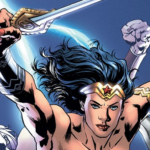
In just a couple short days, Netflix is set to debut THE CHILLING ADVENTURES OF SABRINA, a new supernatural series inspired by the Archie comic book of the same name. While most fans may remember the family-centric sitcom of the 90’s, this twisted take on the popular character seems to be cut from the same cloth as the dark, yet campy RIVERDALE. But Sabrina’s true origins are not nearly as horrific as modern comics and television would lead you to believe.
Sabrina Spellman, along with her familiar Salem the cat, debuted in October of 1962 in the pages of the deceptively-named ARCHIE’S MADHOUSE, a monthly anthology that featured regular Archie characters in weird and often nonsensical storylines, hence the title. She first appeared in the book’s 22nd issue, in a story written by George Gladir with art by Dan DeCarlo. Sabrina became a recurring character in that series. Later, she appeared in ARCHIE’S TV LAUGH-OUT before finally achieving her own title in 1971.
The first volume of SABRINA, THE TEENAGE WITCH, ran for 77 issues before ending in 1983. A second volume saw print in 1996 to coincide with the popular television series starring Melissa Joan Hart. This series was mostly a continuation of the previous volume but incorporated certain elements of the tv series, most notably Salem’s personality. Whereas in the original stories, Salem was an ordinary housecat. The sitcom revealed that Salem was actually an evil witch, hellbent on world domination but was transformed into a cat as punishment. This run ended after thirty-two issues and a third volume, titled simply SABRINA, was released a year later.
Until recently, not many of Sabrina’s adventures would be considered chilling, at least not in the traditional sense. Many of them are pretty… challenging to read, especially in today’s setting. In her debut story, she spends all of five pages introducing herself and providing fun “facts” about witches. We also meet her familiar Salem and her mentor or “head witch” Della. We also learn that witches are forbidden from falling in love with mortals. The act would cause them to lose their powers.
Many of the early stories would explore Sabrina’s desire to please Della and featured her using her magic to play tricks on her fellow classmates, including her magical rival Rosalind. The pair had a dynamic similar to Betty and Veronica. They were often competing against one another for the affection of a handsome gentleman. The only difference here is Betts and Ronnie RARELY ever had to resort to the dark arts to seduce good ol’ Archie. MADHOUSE also featured other zany characters and storylines, including one such story involving Sabrina trading powers with her friend Ronald the Rubber Boy. Seriously.
Without a regular writer, Sabrina’s adventures were less than consistent. Della was all but forgotten after her first few appearances, and her aunts Hilda and Zelda took over as her mentors, with occasional appearances by Sabrina’s fairy witch-mother Greta. These three were pretty much interchangeable both in personality and appearance. Eventually, Hilda and Zelda got some development of their own, while Greta went by the wayside. Sabrina’s own personality is a bit of a mixed bag.
In the early stories, she’s incredibly boy-crazy (think Tina from “Bob’s Burgers” but less awkward and also the magic thing), and nearly always uses her magic to try and get her man, whomever that may be. Even when she casts spells for others, it tends to lean towards her advantage as well. Eventually, she begins using her abilities for others’ benefit, but many early adventures depict her as selfish and mischievous.
Sabrina’s portrayal has changed a lot over the years. The 90’s series depicted Sabrina in a more relatable sense, at least as relatable as any other character from Riverdale. The teenage witch was always working to balance her high school life with her life as, well, a witch, often with disastrous results. Despite the cancellation of both the comic and tv series, the character was rebooted in an animated series, which immediately led to a new comics series set in the same style and continuity. Not long after, she would be rebooted again. This time in a manga-inspired series, followed by more regular appearances in the core Archie books.
More recently the character has had notable appearances in various Archie books, starting with the horror-based series AFTERLIFE WITH ARCHIE, which reimagines the town of Riverdale as it succumbs to a zombie apocalypse. She also had cameos in the amusing but no less bloody ARCHIE VS PREDATOR and ARCHIE VS SHARKNADO, both of which feature the young witch being dismembered.
Following Archie’s line-wide reboot/revival/rebirth/whatever, Sabrina appeared in a fun story-arc of JUGHEAD by Ryan North and Derek Charm. She very nearly strikes up a romance with the burger-obsessed Mr. Jones. Most notably, she can be seen headlining the aptly-titled series, THE CHILLING ADVENTURES OF SABRINA, written by Roberto Aguirre-Sacasa, with art by Robert Hack. Taking place in the sixties, this series explores many of the characters and concepts associated with the mythos but with a decidedly darker take. The book is legitimately scary. Not just in content but in tone and atmosphere – every issue is an intense, creepy and utterly enjoyable read. It’s also very clearly the inspiration for the new Netflix series. Despite the shift to modern times, trailers and clips reveal a tone very much in-line with the comic.
If, like me, you’re excited about the new show, I strongly recommend checking out Sabrina’s comic book adventures. While not every story is a winner, I’d strongly recommend the following:
The Chilling Adventures of Sabrina Vol. 1 (2014)
Jughead Vol. 2 (2015)
Afterlife with Archie Vol. 1 (2014)
The Magic of Sabrina, the Teenage Witch (2011)
All of the above can be found digitally on both Hoopla and Comixology. Print copies can be ordered through Amazon, Barnes & Noble, or check your local comic book store.



